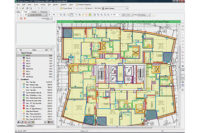Centered on Solutions: Winning More Claims with Strategic Project Management (Part 2)

Editor's Note: Part 1 ran in Walls & Ceilings November 2012 issue. Click here to read Centered on Solutions: Winning More Claims with Strategic Project Management (Part 1).
The chance of losing a claim is a lot higher than any contractor in the construction business wants to admit. Contractors convince themselves of any number of things in hopes that “it” won’t happen to them. Periodic and regular checkpoints across the lifecycle of a project help to identify issues while there is still time for them to be addressed. This review process provides a solid offense for winning claims. Access to information from across the project is critical. There are five essentials to strategic project management: scope, resource, time, money and documentation. If the job shifts from perfect to imperfect, these five critical components will determine whether the contractor makes money on the job or if there is enough information to win a claim. Part one in this series covered scope and resource.
Time is something typically “given” to the contractors by the GC and the subs live and die by this time schedule. Whether the schedule of tasks outlined matches the sequence in which the crews need to work is something that needs to be considered.
The next step is identifying vertically stacked activities to indicate potential conflicts or areas of concern where contractors may be stepping all over one another on a project. Proactively resource loading the schedule must be addressed. This is accomplished by taking the budgeted hours and calculating how many men will be needed to complete each line item in the schedule. When a resource loaded schedule is mapped onto a chart, it should look like a modified/gradual bell curve. If it does not, then there are unbalanced resources which could take the project off course (time and budget). If a problem arises, be certain to communicate the problems to the GC early and regularly and ask for relief. If the contractor doesn’t make the GC aware of a potential situation or ask for assistance when he is aware there is a problem it will be harder to be granted that relief later in the project.

JOB COST ACCOUNTING SOLUTION
In order to manage the Money, contractors need a solid job cost accounting system. Estimated quantities must be identified from the thorough and complete takeoff performed by the project manager before beginning the build. In addition, the installed data quantities should be gathered from the job site using automation tools that will be instantly communicated back to the office. The next step is to align that information to the weighted average value of those areas otherwise there will be erroneous results.
The next information needed is the estimated time from the PM’s estimate and the actual time from the payroll time cards. This information will allow the calculation of the percent complete of the job. Projections for final costs will show potential claims based upon the information the numbers expose. Now this following point is critical: don’t ignore the analytics—the numbers don’t lie. If contractors don’t pay attention to these projections they will have a problem at the end of the project and it will be too late to correct the issue.
SOLID DOCUMENTATION
Documentation is arguably the most important of the five essentials. Documentation must be started from the beginning—not when the situation dictates its need. The crew simply won’t remember the details. Without good documentation it will be a war of “your word against theirs” when it comes to supporting (or defending) a claim. A delay letter should not be confrontational but rather be informational to avoid a claim before it happens. Make this communication very clear and include details such as activity, area, delay start time, delay end time, and elapsed time (net work days minus any holidays in that window) when known. This provides a lot of credibility when having a conversation related to the delay.
The best time to pull together this information is the day before the regular job status meeting. Share this information with the superintendent before the meeting allowing him to discuss this situation with each of the appropriate contractors at the status meeting.
The other important aspect of documentation is tracking the measured mile. It is a legal premise where contractors measure off effected work. Identification of the estimated time to complete is compared to the actual time spent. Analyzing the factors that caused the cost overrun is most effective when using automation tools because the work is time stamped and easily reflects the work status. Photograph and take videos of the situation and store the support data within the automation tool then carry the tablet into the meetings. Creating solid documentation takes away the “your word against theirs” weak-link in a claim.
A claim isn’t a strategy to make money. Rather filing a claim is a way to avoid losing money or to recover money. Start from a position of strength. Focus on the five essentials: scope, resource, time, money and documentation. If the claim is well documented, the other parties may not push back once the information is shared. Strategic and proactive project management is the argument winning tool for a claim.
Looking for a reprint of this article?
From high-res PDFs to custom plaques, order your copy today!









